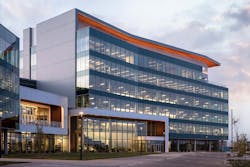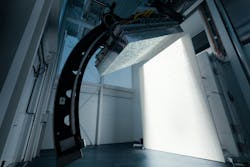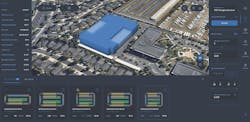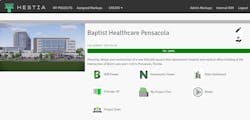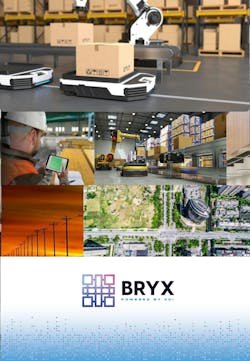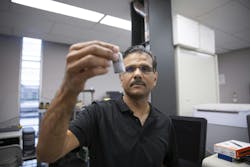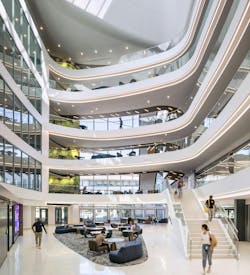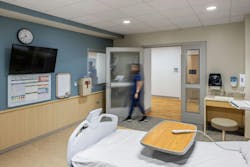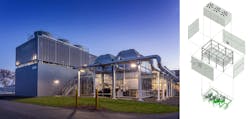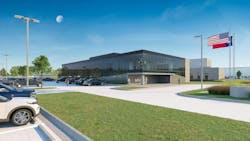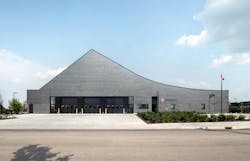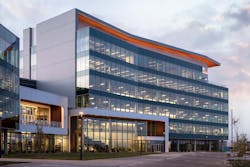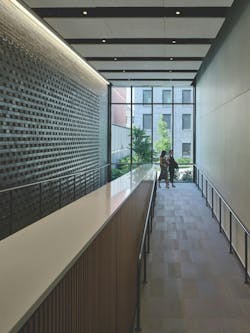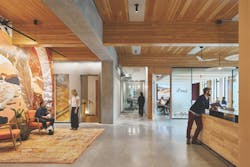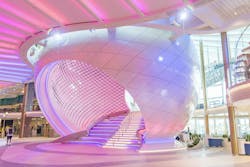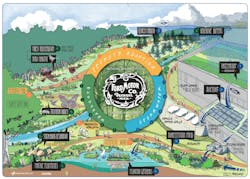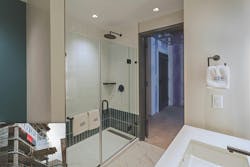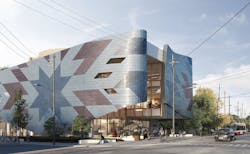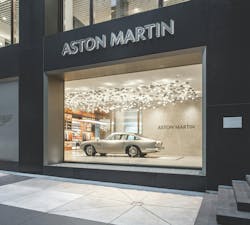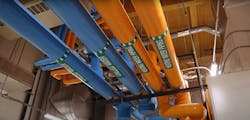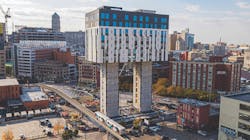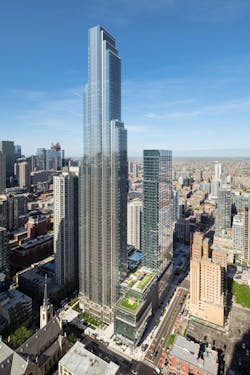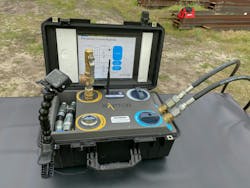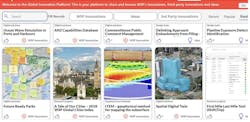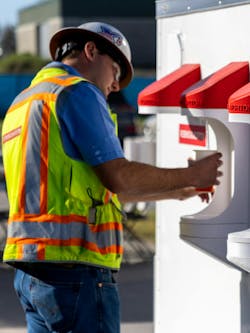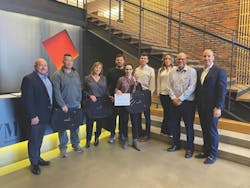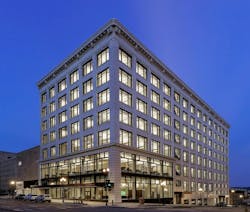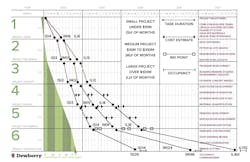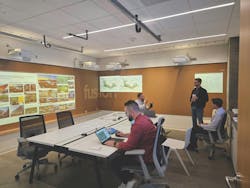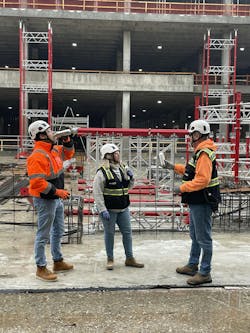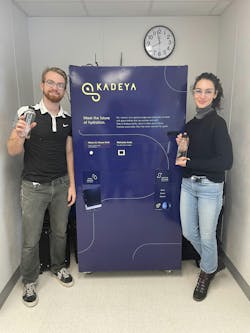41 Great Solutions for architects, engineers, and contractors
By BD+C Staff
AI ChatBots, ambient computing, floating MRIs, low-carbon cement, sunshine on demand, next-generation top-down construction. These and 35 other innovations make up our 2024 Great Solutions Report.
In January 2024, the Building Design+Construction editorial team invited the nation’s largest architecture, engineering, and construction firms to submit their single-biggest innovation from the past 24 months. More than 80 firms responded with well more than 100 submissions. The editors selected the top 41 Great Solutions. They are presented below organized in four categories:
- Technology solutions
- Design solutions
- Construction solutions
- AEC firm operations solutions
10 technology Great Solutions for AEC firms for 2024
1. Building system uses light, sound, even scent, to engage with building occupants
Submitting firm: Arup
A first-of-its-kind system in the smart building space, BREO (Building Resource Expression for Occupants) brings a fresh approach to communicating and engaging with building occupants, especially around sustainability and building performance.
The system, designed by engineering giant Arup, monitors and translates building data—such as energy usages, water consumption, and indoor air quality—into an immersive sensory experience using lighting, sounds, and even scents. The objective is to encourage occupants to actively contribute to building sustainability.
For example, BREO might change the color of the ambient light to indicate how the building is meeting its power use targets, modify the soundscape to signify water consumption overages, or add a subtle odor to the air to indicate poor but imperceivable interior air quality.
“Occupants are already responding to their environment in myriad ways—adjusting lighting when the sun sets or changing the thermostat on a cold day. BREO builds upon this behavior and gives them more agency in reducing consumption,” states Arup.
Thus far, the BREO technology has been explored in Arup’s Los Angeles office and some residences with larger opportunities for implementation on the horizon.
2. Post-occupancy evaluation app yields future improvements
Submitting firm: LEO A DALY
Ryan Companies’ CheckpointPost POE tool uses a custom app, visual data-driven dashboards created in PowerBI, survey room schedules integrated through Revit 360, and an integrated room mapping system to gather feedback from stakeholders on successes and areas of improvement, thereby cutting the time spent on routine survey tasks.
CheckpointPost also fosters continuous improvement in design and construction practices and helps Ryan make informed decisions for future projects. One such assessment revealed an underutilized space that could be repurposed into rentable square footage. Another CheckpointPost POE exposed inadequate lighting in a critical gathering space. Both POE findings will be applied to the design of future projects.
3. Sunshine on demand in a Swiss lab
Submitting firm: ETH Zurich
On its Hönggerberg campus, Switzerland-based university ETH Zurich has established a Zero Carbon Building Systems lab, opened in the fall of 2022, that can simulate climatic conditions to test new building systems, components, and materials. The lab’s central feature is an artificial sun comprised of hundreds of LEDs fixed to a movable arm, allowing the system to imitate the path of the sun to test the effects of solar radiation. The outer walls, floors, and ceilings of the lab’s three research cells can be replaced with prototypes developed in the Robotic Fabrication Lab next door, to be tested onsite. One of these is a semi-transparent façade made of printed polymer, whose structure either deflects sunlight or allows it to pass through, depending on the angle of incidence.
In addition to the artificial-sun room, the other two test cells on the south side of the building are exposed to natural sunlight and the outdoor climate. Lab testing is currently possible for heating and cooling systems, ventilation concepts, PV and thermal applications, digital fabrication, human comfort, sensor development, and model validation.
Soon to be tested are 3D-printed components for façades that can passively conduct solar heat from the façade to the building interior or act as insulators if required. The lab is further developing an adaptive solar façade whose movable solar panels track the position of the sun, maximizing energy gain.
4. McCarthy SiteShift generates parking structure designs in minutes
Submitting Firm: McCarthy Building Companies
McCarthy SiteShift by McCarthy Building Companies is a collaborative solution for parking structure planning and design. The virtual tool allows for McCarthy, its clients, and parking experts to create conceptual parking layouts in a matter of minutes. SiteShift benefits from decades of real construction experience to inform its generative AI to optimize for space, constructability, and cost. After the iterative design process is complete, SiteShift creates a full PDF package from its 3D Revit model and provides clients with quantifiable data.
With SiteShift, McCarthy is able to focus greater time and attention on the more important aspects of a project. More at www.siteshift.io/p/1.
5. Get ahead of low-carbon building performance requirements with this early-stage design tool
Submitting firm: Arcadis
With Arcadis’ ClimateScout sustainable architecture design tool, project teams can identify climate-specific design strategies at the earliest stages of concept design that will help reduce a project’s operational carbon intensity. The free web-based tool (now in Version 2) offers pre-selected strategies based on the 27 building scale strategies from Architecture 2030’s Palette and the Köppen-Geiger climate subtypes. After clicking on a world map to select a climate zone, ClimateScout takes the user to a page to build a section combining appropriate strategies for a selected climate. As they are selected, the design strategies appear in real-time overlaid in diagrammatic form, providing an immediate visual connection between the climate and the architectural idea, according to Arcadis.
New to Version 2 is a carbon tool that allows users to determine the grid’s impact on operational carbon intensity. A world map provides grid carbon intensity for all countries worldwide. Energy Star’s Target finder can be used to determine the Median EUI for the type and size of property in the location selected. Using the information from Target Finder, the carbon calculator will estimate the carbon intensity (kgCO2e/m2yr.) and the total carbon emitted per year (kgCO2e/yr.), assuming the building is all electric. Different targets can be selected and calculated.
6. Interactive client portal opens door to project deliverables
Submitting firm: Gresham Smith
Gresham Smith’s Hestia interactive portal enables clients to engage virtually with their projects. The dashboard houses all deliverables—BIM models, renderings, drawings, project team details, statistics, final images, and videos—giving clients an up-to-the-second visual snapshot of the project's status.
Clients can view current drawings and navigate the space via Enscape 3D. Using Navisworks Viewer, they can inspect each elemental model simultaneously; for example, ensuring the HVAC system aligns with electrical, plumbing, and structural elements. A Power BI dashboard instantaneously provides project stats, such as the relative humidity of each space.
The proprietary platform's round-the-clock accessibility and robust security measures make it a reliable tool for clients to monitor progress and provide feedback—at their convenience.
7. AI tool helps Skanska share data internally and securely
Submitting firm: Skanska USA Building
2023 was a breakout year for AI, even for the normally tech-allergic construction industry. One of the frontrunners was Skanska, which last year introduced a proprietary chatbot called Skanska Sidekick, the development of which required collaboration across the firm’s functions and offices worldwide. Built on the Azure OpenAI platform, Sidekick allows users to upload and query personal docu- ments, such as meeting minutes, from which the program provides insights, summaries, and answers. Sidekick delivers the benefits of Generative AI tools while keeping users’ prompts and docs safe on Skanska’s Cloud.
Late last year, Skanska USA Building’s Data Solutions Team developed a proof-of-concept tool that indexed thousands of historical scopes of work while integrating project metadata from sources within Skanska’s data warehouse. The team has also created dynamic training materials to help employees understand strengths and limitations of Gen AI tools. These efforts can be seen as the culmination of Skanska’s five-year data investment strategy, whose goal is to better ensure meaningful ROI, improve decision making, and keep the firm aligned with AI’s rapid evolution.
8. Engineering giant brings ‘model-as-a-service’ AI tools to the AEC industry
Submitting firm: KCI Technologies
This past February, engineering firm KCI Technologies became the latest AEC firm to market in-house-developed tools to the greater AEC marketplace. Through its newly launched BRYX platform, the firm has developed and released four online tools, with 12 more in the works.
KCI describes BRYX as a model-as-a-service (MaaS) platform, offering ready-to-run machine learning, computer vision, and computational models for AEC firms looking to utilize AI tools without taking on the model development, training, and management work needed to build them from scratch.
The four models currently available include:
- Personal Protective Equipment (PPE) Detection, which analyzes aerial construction site images and quickly detects and labels PPE used on site, including head gear, boots, gloves, full body harnesses, safety vests, self-retracting lifelines, and anchorage points.
- RobotFlat is designed for use on robotic warehouse and distribution center projects that require critical-tolerance concrete floors to ensure optimal conditions for robotic systems. It allows AEC firms to calculate concrete floor flatness and identify areas that need remediation.
- Traffic Control Device Detection, which allows teams to quickly identify any missing or mispositioned traffic control devices and quickly replace, secure, or repair them as needed. It’s programmed to monitor and detect 18 distinct traffic control devices on jobsites, including cones, concrete barriers, lights, construction safety fences, automated flagger devices, work vehicles, and temporary traffic control signs.
- Power Pole Equipment Detection analyzes utility pole images, classifying the equipment detected on the pole, including animal guards, bracket poles, bell insulators, fuses, LED lights, and crossers.
According to KCI, BRYX’s interface allows users to easily upload data, run models, monitor model performance, and access output files and logs. Also, its application programming interfaces (APIs) support rapid integration of models into third-party applications. Free trials are available for all the tools.
9. FOScore brings facility management to your pocket
Firm: FOS of CannonDesign
FOS of CannonDesign’s FOScore is an all-in-one facility assessment software for AEC firms and building owners alike. FOScore allows its users to assess and document facility conditions, featuring interactive visuals, AI generated asset information, and many other modules. The Total Cost of Ownership (TCO) module gives facility management teams a 50-year outlook on the property, helping them and their clients understand its total cost of ownership. Other features such as the KPI module help track a building’s goals, from energy utilization to accessibility, safety, and security.
10. Producing concrete with less carbon output
Submitting Firm: Arizona State University
After water, concrete made from cement is the most-used material in the world, with more than 30 billion tons created annually. But the process of converting cement manufacturing’s chief ingredient, limestone, to a binding component cement clinker requires intense heat that emits CO2 equal to about one-quarter of all industry carbon emissions. Manufacturers have made strides to lower cement production’s carbon footprint, such as Cemex’s Vertua cement that uses less energy to make. Last October, the National Science Foundation awarded a research team at Arizona State University a four-year, $3 million grant to investigate the feasibility of two lower-emissions manufacturing solutions: separating lime from limestone via electrolytic and hybrid routes without producing CO2; and using autocatalysis, which provides energy from renewable sources. Narayanan Neithalath, a professor at ASU leading this research team (pictured), says that given concrete’s ubiquity as a construction material, stemming CO2 emissions must begin at the production stage to have global impact. His team’s research, he says, is “baby steps” toward that goal.
17 design Great Solutions for AEC firms for 2024
1. Hidden in plain sight: This Costco is one with nature—and the community
Submitting firm: MG2
Forget the $1.50 hot dog combo special. How about a pickup game of basketball or fútbol? Or a stroll along manicured gardens? Yes, indeed, this Costco Wholesale location in Mexico City is like no other.
Located within the Parque La Mexicana 70-acre urban green space in the city’s Santa Fe neighborhood, the 524,549-sf store, warehouse, loading bay, and parking structure are tucked under a sprawling active green roof that features a fútbol field, padel court, children’s roller park, green roof, and multiple hybrid basketball/volleyball courts. It also connects to the larger urban green space and jogging path via a pedestrian bridge.
Only one side of the building is exposed to the public. The other three sides are concealed using the existing landscape. “Montanitas,” or tall berms covered in native plants, trees, and grasses work double duty to camouflage the warehouse exteriors while minimizing the irrigation and water usage required to allow them to flourish. Green facade screens with native crawling vegetation planted at its base as well as cascading down from the roof above will grow over time to further obscure the warehouse and parking structure’s appearance, according to MG2.
2. Emory University’s new building keeps vibrations under control
Submitting firm: HOK
For its design of Emory University’s eight-story, 350,000-sf Health Research Science Building II, which houses over 1,000 researchers and sensitive technology, HOK had to mitigate vibration from a trifecta of sources:
• Site-borne vibration from an adjacent rail line was reduced predominantly by providing sufficient building mass at the slab in the vicinity of the rail line. HOK worked with a vibration/acoustic consultant to fine-tune the necessary amount of mass without requiring an undue volume of concrete.
• Wind-induced vibrations on lightweight elements of the building, such as trellis structures, were kept within acceptable limits through a study of those elements’ dynamic properties, including maintaining minimum fundamental frequency values to avoid resonance or flutter.
• Pedestrian-induced vibrations on the building’s floor framing were addressed through parametric interdisciplinary optimization studies to arrive at the appropriate balance of structural depth, MEP service depth, and location-specific vibration performance. This allowed for vibration control and space for high-efficiency MEP systems within laboratory spaces within constrained story heights. Perhaps counterintuitively, connecting the 20-foot cantilevered stairs to 15 70-foot-long pedestrian bridges improved the bridges’ vibration performance.
3. HVAC system enables infectious disease isolation space for ICU
Submitting firm: Studio+
For the Lee Health Cape Coral (Fla.) Hospital ICU expansion, architecture firm Studio+ designed an HVAC system that enables the new addition to become a self-sustained negative-pressure wing, creating a much larger isolation patient space in the event of a pandemic or widespread infectious disease outbreak.
The breakthrough system was prompted by the Covid pandemic and the need for ICU staff to be able to adjust the HVAC system to create a negative space that would expel all air to the outside without any recirculation.
To meet this demand, the unit required a bigger AC unit that could support the exhaust requirement. It would operate as usual until the need arose to operate in pandemic mode. The new system has extra dampers and exhaust fans that, when activated by the BMS administrators (in conjunction with infection prevention) close off the return ductwork. Next, the exhaust opens, and the fan brings 100% outside air into the space and exhausts 100% indoor air out. While in this mode, certain room functions can be altered for isolation purposes; for example, the family waiting area becomes the donning and doffing space.
4. Heat sharing makes a research campus in Washington State more efficient
Submitting firm: Kirksey Architecture
The Energy Sciences Center opened on the Richland, Wash., campus of Pacific Northwest National Laboratory in January 2022. This $90 million, 140,000-sf, net-zero-ready building meets the U.S. Department of Energy’s Guiding Principles for Sustainable Federal Buildings, thanks to energy efficient design strategies that included a standalone Heat Transfer Building and below-grade campus-wide heat-sharing system. The heat-transfer building, which connects several buildings on campus, uses data center waste heat to support the Energy Sciences Center that was designed to prioritize cooling and heating sources with low-carbon intensity.
During summer months, the building’s below-ground Heat Transfer Water system acts as a central condenser water plant with a common cooling tower adjacent to the Center. In the winter, this heat-sharing network allows for free heat from facilities with a year-round cooling demand (data centers, process loads, etc.) to be rejected into the loop and reused for reheat of the incoming ventilation air in more heating-driven laboratory buildings. The building hydronic systems capture this waste in a 200-ton modular heat recovery chiller for low-carbon, heat-pump based heating. This system is supplemented by a natural gas condensing boiler that, at full buildout, is needed only during peak heating demand. The building team included Kirksey Architecture (architect, lab planning, interior design), Harvey|Cleary Builders (design builder), Arup (SE, MEP, CE), J-U-B Engineers (landscape architect), and Vibrasure (vibration/acoustical consultant).
5. Floating MRIs offer design flexibility and patient convenience
Submitting firm: CO Architects
At the University of California Irvine Health–Irvine Medical Center (UCIHIMC), whose construction will be completed in September 2025, a vibrationally isolated “floating room” was a no-brainer design solution for all four MRI machines on this under-construction campus. Locating MRIs above grade alleviates these rooms’ notorious acoustic and vibration issues. Further, it protects imaging quality from the surrounding infrastructure. UCIHIMC places the MRIs centrally, at the entry level, for ease of patient access and within the imaging department, for uninterrupted care from staff and close to other imaging machines such as Xray. Key components include floor springs to elevate the room slab from the building, sway braces that provide a buffer between the building and the MRI room’s walls, and a self-supporting framed top. Lining the room’s substructure are layers of copper radio-frequency shielding and steel magnetic shielding. UCI Health-Irvine’s floating MRI room is a design first for CO Architects. The project’s other team members include Hensel Phelps (GC), Degenkolb (SE), WSP | tk1sc (ME engineer), Collin Gordon (vibration consultant), Nelco (shielding consultant), Newsom Brown (acoustic consultant), and CDM Stravitec (spring engineer).
6. Stantec delivers six schools in less than three years
Submitting Firm: Stantec
Stantec and its project partners delivered a first-of-its-kind bundled delivery of six schools for the Prince George’s County (Md.) Public School System (PGCPS). The school district’s existing facilities were overcrowded and aging, so Stantec designed an adjustable prototype to meet the individual needs of six new ones. The schools feature grade-specific academic wings, STEM/STEAM labs, media labs, production studios, performance stages, indoor gymnasiums, and more. Additionally, various sustainability elements include tubular skylights and large windows to increase natural daylight. Through local business utilization and a 30-year public-private partnership, PGCPS was able to save $174 million in deferred maintenance and construction costs.
7. Ambitious testing facility accelerates space research
Submitting Firm: Burns & McDonnell
Burns & McDonnell partnered with Intuitive Machines, a Houston-based diversified space company focused on space exploration, to design and build its new headquarters and flame range test facility. The first-of-its-kind concept integrates workspaces, laboratories, and testing facilities to foster collaboration and accelerate space research. By having the test facility located next to the headquarters, Intuitive Machines will benefit from lower testing setup costs, streamlined logistics, and full utilization of its manufacturing capabilities. The integration of energy-efficient solutions and streamlined construction processes resulted in cost savings for the client, creating a model for future projects to follow. Additionally, its 105,572-sf headquarters serves as the operations center for the company’s lunar program, which will attempt landing the first American spacecraft to the surface of the Moon since the Apollo program in 1972.
8. Canada’s first net-zero energy fire station
Submitting firm: GH3
While achieving net-zero energy is now an ambition of a growing number of projects, getting there has many routes. Take Windemere Fire Station No. 31, a 16,490-sf building in Edmonton, Alberta, that was completed last June. The City of Edmonton wanted a highly sustainable project that would generate on-site renewable energy equal to 100% of the total building energy needs. The facility’s energy performance had to be 40% more efficient than the National Energy Code of Canada for Buildings 2011, reduce carbon emissions by 40% under NECB 2011’s baseline, and operate at 80 kilowatt-hours per square meter per year for heating needs.
Windemere’s design reimagines the typical hose and bell tower form with a curving, south-facing roof sporting a PV array. A geothermal heating and cooling system is incorporated, as are high-performance windows and exterior doors, although the facility has significantly fewer windows than the average firehouse and uses bi-folding and quick-closing bay doors to limit heat loss.
The team for this $12.7 million project included gh3 (design and landscape architect), S2 Architecture (consultant), Urban Systems (landscape), RJC Engineers (SE), Smith and Anderson (ME engineer), Ecoammo (sustainability), and PCL Construction (GC).
9. POE studies validate energy, lighting savings
Submitting firm: LEO A DALY
LEO A DALY used 845 SageGlass electrochromic glass panels for the skin of financial services firm Carson Group’s national headquarters, in Omaha, Neb. The giant AE firm designed all building systems for the twin four-story glass towers and two-story amenity zone in concert with the SageGlass envelope, which allowed them to downsize the HVAC system and save $100,000 in equipment costs. A subsequent post-occupancy evaluation confirmed 15% energy savings in heating and air-conditioning and 74% energy savings in lighting use, with no negative impact on air quality or thermal comfort for occupants.
10. Passive House, biophilic senior living community promotes health and wellness
Submitting Firm: Cookfox Architects
When seniors are more susceptible to breathing in airborne viruses and pollutants, the buildings they live in should mitigate as many health-related issues as possible. COOKFOX Architects designed Betances Residence, an affordable housing community for at-risk seniors in Bronx, N.Y., with embedded biophilic and Passive House principles. Designed to be airtight, all residential units are continuously supplied with filtered air to combat breathing in pollutants often found in the south Bronx. Active design strategies at Betances encourage physical activity among residents. An agriculture green-roof and constant views of the central courtyard instantiates biophilia, calming and connecting seniors to nature.
11. Developer-driven PAE Living Building comes to life
Submitting firm: ZGF Architects
The PAE Living Building is the first developer-driven and largest commercial office Living Building in the world. Built on an existing parking lot, the ZGF Architects-designed structure adds appeal to the Portland, Ore., historic district. Certain project financing decisions were crucial in getting the PAE Living Building off the ground: The location gained federal tax incentive benefits from being in one of Portland’s 11 Opportunity Zones, and partners offered their fees as equity. The building aims to prove that meeting the highest sustainability standards can be financially viable in a developer-driven model.
12. An orb girds and opens a cruise ship’s depths
Submitting firm: Wilson Butler Architects
A goal for Royal Caribbean’s latest cruise ship project was to connect guests with the ocean experience, while providing more natural light in the lower public decks. The 20-deck-high Icon of the Seas, which embarked on its maiden voyage January 27, 2024, addressed this challenge by providing a panoramic window wall three decks high and almost 100 feet wide, that flooded its Royal Promenade neighborhood with natural light. To create an unobstructed view over the Lifeboat Deck 5, the window and adjacent café lounge were raised to Deck 6. Guests are attracted to this elevated lookout through The Pearl, a 53-foot-diameter white sphere lined with an immersive art installation. The Pearl doubles as a load-bearing superstructure that supports the decks above, freeing the space of any visible columns. Finland-based ship builder Meyer Turku worked with Wilson Butler Architects on the Icon of the Seas’ initial planning to integrate the Pearl into the ship. Mobimar, a Finnish engineering and outfitting company, oversaw the exterior cladding and installation of the art piece. Breakfast Studio, based at the Brooklyn (N.Y.) Navy Yard, created the installation’s 3,000 kinetic tiles whose movements evoke the ocean’s natural rhythms.
13. Anticipating the need for EV chargers
Submitting firm: CESO Inc.
Failure to account for future demand for EV charging stations can be a costly mistake for property owners and businesses. Engineering firm CESO Inc. anticipates infrastructure demand for future EV ports by designating future locations of the ports and ensuring that conduits are strategically placed under paved areas on the site to prevent disruption in the event of future EV charging installation. A “No Build Area” shows where chargers will be installed to warn other utilities from digging there.
When it comes time for a client to install EV ports into a site, having the infrastructure in place reduces the implementation time and minimizes disruptions to the client’s day-to-day operations. CESO experts stay current on EV infrastructure regulations, permitting, and approval processes, to make sure its clients stay compliant with EV industry standards.
14. Bringing the built environment closer to nature
Submitting firm: Jacobs
Since 2017, Jacobs has been collaborating with the consultancy Biomimicry 3.8 on large-scale built environment projects that learn from nature, to have a positive impact on all life. (Jacobs and B3.8 entered into a strategic alliance in November 2020.) These projects are designed to function like a healthy ecosystem and provide the same benefits. At its foundation, the Positive Performance Methodology recognizes the built environment as an integral part of nature, that can, in fact, function like nature, delivering the same suite of ecosystem services at the same performance level as local intact ecosystems. The goal of this multidisciplinary approach is to deliver campuses, communities, and cities that are regenerative and resilient. Jacobs’ work has included multiple sites for Ford Motor Company, which is actively implementing nature-positive solutions whose initial phases of development should be completed by early 2025.
Jacobs measures the performance of a site against seven key metrics—air quality, biodiversity, water quality, health and wellbeing, carbon and climate, water cycle, and soil—and then evaluates the proposed design intervention against those benchmarks.
15. 20 Mass converted into mixed-use urban hub
Submitting Firm: LEO A DALY
20 Massachusetts Avenue in Washington, D.C., is an adaptive reuse project that combines office, retail, and hospitality under one roof. Redeveloped from a former government building, the new mixed-use structure includes penthouse suites and amenities, street-level retail, and a 271-key luxury Royal Sonesta brand hotel. LEO A DALY reinvented 20 Mass with the help of field technology, such as laser scanning of existing structures, to inform design and construction decisions. Creative modular construction also played a role; the team engaged with SurePods for the hotel bathrooms, reducing waste by 50% and saving $500,000 in general conditions.
16. Partnership creates process for real-time design/constructability vetting
Submitting firmS: Perkins&Will and A. Zahner
Architecture giant Perkins&Will and fabrication partner A. Zahner Company have developed an innovative design process that elevates the quality and efficiency of projects. Known as Dynamic Design and Feasibility, the process provides transparent and continuous vetting of design and constructability, known as feasibility loops, that connect architects, designers, engineers, fabricators, and installers in real time. It results in faster decision making, encourages creative iterations, and ensures the delivery of high-quality solutions to clients, particularly for ambitious building designs with complex geometries, unique materials, and tight timelines.
Dynamic Design and Feasibility has led to increased design productivity, higher design fidelity from concept to fabrication, and enhanced design excellence at Perkins&Will. The initiative offers protection against potential losses from rework and revisions, minimizing unexpected surprises and reducing the need for value engineering.
Perkins&Will and Zahner have collaborated on more than a dozen such projects, four of which will start construction this year.
17. Mr. Bond would approve of the immersive showroom
Submitting firm: Alexander Zilberman Architecture
Aston Martin—they made the DB5 that Bond drove in “Goldfinger”—commissioned Alexander Zilberman Architecture to create an immersive experience for its clients at Q New York, its new showroom at Park and 57th in Manhattan, while also giving passersby a deep visual dive into the showroom.
To complement the existing building’s architecture, the designers used super-transparent, low-iron glass with low-e coating and UV light reduction for clear, low-reflectivity views inside while allowing the highest possible VLT and energy performance.
Champagne chamfered metal panels and custom mosaic tiles within each of six column bays define the so-called “Champagne Frame” view from the street. The glass fabricator manufactured each 22-foot-wide, 11-foot-tall IGU to resist structural deflection and wind and moisture ingress.
6 construction Great Solutions for AEC firms for 2024
1. Talk about a tight squeeze!
Submitting Firm: DPR Construction
DPR Construction had to jam a five-story, 35,000-sf structure within inches of three historic buildings in Nashville’s busy Broadway Historic District. With less than a foot of clearance and no swing room for a tower crane, installing prefab exterior panels the traditional way was out of the question.
DPR turned to the Upbrella system, which uses a bridge crane suspended from the exterior of the structure to lift the panels off delivery trucks and onto trolley cranes mounted on a monorail that circumnavigates the building. Once the panels are in place, DPR’s self-perform team secures them to the floor deck from inside the building.
2. Cutting water damage losses
Submitting firm: Warfel Construction
Warfel Construction’s Wet Work Program and Wet Work Permitting procedure identify and mitigate risk when working with active water systems. Water damage losses caused by work involving water piping, pumping, drainage, or mechanical building systems can be prevented or reduced by implementing a prevention plan.
The Wet Work Program includes tagging and identification of shut-off valves, posting shut-off valve location drawings throughout the work area, the use of flow monitors or water watch personnel, and readily available plans or equipment for containment should a leak occur.
Warfel expects the Wet Work Program to reduce its water-loss costs by 30% or more in its first year.
3. Offsite construction aids in adding eight aircraft gates for LAX
Submitting Firm: W.E. O'Neil Construction
Los Angeles International Airport (LAX) is building eight new gates in an accelerated time frame thanks to offsite construction and relocation (OCR) methods. Utilizing the OCR method, MSC South at LAX is being constructed in nine segments roughly a mile and a half away from the project’s site and, once complete, will be carefully delivered and assembled in place. Los Angeles World Airports is spearheading the concourse with a team that includes W.E. O’Neil Construction and Woods Bagot Los Angeles—a first-of-its-kind for offsite construction at LAX. Construction on MSC South’s core and shell is proceeding with significant project completion planned for 2025.
4. LIFTbuild’s top-down residential building concept comes to life
Submitting firm: LIFTbuild
The dated approach of top-down construction has been reinvented with LIFTbuild’s concept-to-completion project, Exchange. The team utilized a “vertical manufacturing” approach to the design, procurement, and assembly process. LIFTbuild leveraged its assembly line model with a generative design process that could identify the most optimal building configuration based on budget and programmatic needs. The high-rise building itself consists of structural concrete spines and steel-framed decks for its roofs and floors. Estimates to a conventionally-built digital twin of Exchange revealed LIFTbuild’s technology offers schedule improvements of up to 30% and cost reductions up to 20%.
5. Top-down construction shaves eight months off residential high-rise development
Submitting firm: Goettsch Partners
Top-down construction is not new, but we may see more building teams implement this efficient construction method to meet increasingly aggressive project schedules, budgets, and client demands, especially on mega projects.
That was the case for Goettsch Partners, Hartshorne Plunkard Architecture, Power Construction, and JDL Development on the 2.2 million-sf One Chicago residential mixed-use development in Chicago. Stretching an entire city block, the $500 million development features two residential towers—one 77 stories, the other 49 stories—connected by a 10-story podium and four levels of underground parking.
To help compress the construction schedule, the team turned to top-down construction, whereby the basement levels of the project were excavated simultaneously with the erection of the vertical structure above.
“By accelerating the vertical growth, our team reduced the schedule by eight months,” according to Goettsch Partners. “This method accelerated the schedule for a quicker turnover to the client, which in turn expedited turnover to rent units and sell condominiums.”
The top-down method is particularly applicable to large-scale projects with complex below-grade structural work and high-rise buildings. Goettsch said the combination of the height of the towers, four levels of underground parking, and an earth-retention system stretching an entire city block made top-down construction the ideal method.
“While construction was occurring underground, the tower was rising on top, which allowed for the windows, drywall, and other materials to be put in place to accelerate delivery of the apartment units,” the firm added.
6. Taking the pressure off pressure testing
Submitting firm: The Haskell Company
Pneumatic pressure testing, which uses air or inert gases like nitrogen to pressurize piping systems, can be dangerous because it typically requires operators to be close to the testing area. The Haskell Company, a Florida-based AEC consulting firm, through its Dysruptek innovation and venture capital arm, has developed equipment called RAPTOR (which stands for Remote Activated Pressure Testing Observation and Recording) that minimizes risk via WiFi-enabled remote testing by operators outside of a site’s exclusion zone. RAPTOR is not only safer but less labor-intensive: Its design includes quick-connect ports for efficient setup and teardown, a wireless gauge for accurate PSI monitoring, and robust failsafe systems such as pressure-release and abort functions. Kickr, a product design, engineering, and manufacturing company, helped create the prototype. Haskell holds the patent on RAPTOR, and is pilot testing its second version with external partners.
8 AEC firm operations Great Solutions for 2024
1. Engineering firm launches student loan repayment match
Submitting firm: Kimley-Horn
In the battle for talent, AEC firms are pulling out all the stops to attract and retain the best and brightest. In January, engineering giant Kimley-Horn launched its student loan repayment match program. The initiative is structured to help employees build their retirement savings while paying down their student loans.
Once an employee reaches their one-year anniversary, the firm will “double-match” the employee’s 4% 401(k) contribution with an 8% company contribution.
In addition to the 200% match, for decades Kimley-Horn has provided a profit-sharing contribution to employees’ 401(k) plans. In most recent years, the firm has paid an additional 10% of employees’ salary plus bonus into their 401(k). The firm, therefore, provides a total contribution of 18% of employees’ salary plus bonus to their retirement accounts.
Kimley-Horn is using SoFi at Work’s Student Loan Verification (SLV) service. Kimley-Horn identifies eligible participants, SoFi at Work verifies the student loan payments, and Kimley-Horn’s 401(k) partner, T. Rowe Price, delivers the contributions for retirement matching.
2. Web-based platform tracks innovations at global engineering firm
Submitting firm: WSP
Engineering giant WSP’s web-based Global Innovation Platform enables its designers to share best practices, foster collaboration across regions and sectors, and solve problems for clients instead of reinventing them. From embodied carbon algorithms to noise calculation tools, from construction sequence animations to rapid structural prototyping for project feasibility, WSP designers can search for solutions using tags such as Equipment and Methods, Business Process, Design Tools, and Digital Solutions—and do so by practice area, project type, or innovations.
The searchable database of more than 500 innovations provides a description of the solution, current applications, associated projects, and contacts. The latest version added a third-party technology component that accelerates smart building solutions. The platform also tracks R&D efforts. One such research project is studying two ways to insulate historic load-bearing masonry without deterioration.
3. Training program leads to construction careers
Submitting firm: Messer Construction
When Messer Construction got the contract for the 650,000-sf, 249-bed Cincinnati Children’s Critical Care Building, it created its own program to move underemployed and unemployed members of the surrounding community—especially minorities and women—into full-time construction careers.
The Urban Workforce Development Initiative (UWDI) starts with a 12-week paid “work hardening” program through Easterseals Redwood Building Value. The training reinforces nontechnical job skills—teamwork, punctuality, safety, having the right tools every day—and exposes candidates to the reality of jobsite conditions without having to be on one.
Graduates earn three months of paid, hands-on training, mentorship, and professional development working as a co-op for Messer or a subcontractor partner. Successful co-op grads go on to full-time jobs with Messer or one of its subcontractors.
Each UWDI participant has a one-on-one case manager to help overcome problems related to housing, transportation, financial literacy, education, healthcare, and childcare.
To date, Messer has placed more than 100 individuals into construction careers through UWDI.
4. Quenching jobsite workers’ thirst sustainably
Submitting firm: Robins & Morton
Workers on the jobsite of the 282,000-sf AdventHealth Riverside Hospital project in Riverview, Fla., were drinking water at a rate of at least eight pallets of single-use bottles per month. To lower that plastic waste and create a more sustainable construction site, as well as reduce the estimated $50,000 spent annually on single-use bottles, Robins & Morton, the project’s GC, developed a water-bottle refill station prototype, called Water on Wheels, which debuted last October.
The firm’s Sustainability and Innovation teams started by running an outdoor power source and water supply line into an enclosed trailer. The teams 3D-printed four water dispensers that are embedded into the side of the trailer. Inside the trailer is a chiller capable of cooling 32 gallons of water per hour at 50 F. The trailer is equipped with carbon and UV filters for purification. (Robins & Morton consulted with OSHA about preventing contamination.) The trailer also has space to double its filtering and chilling capacities for larger projects.
Since introducing its prototype, Robins & Morton has built two more Water on Wheels stations that are connected to the Internet for analytical purposes.
5. Diverse Partnerships Program builds lasting relationships
Firm: Shawmut Design and Construction
Shawmut Design and Construction shows its dedication to supporting DEI initiatives with its Diverse Partnerships Program. The program is designed to provide greater opportunities for vendors, subcontractors, and suppliers that represent diverse communities. Shawmut aims to build lasting relationships and strengthen business opportunities with Underrepresented Business Enterprises (UBEs), aided in part by the firm’s Building Partners Series—a four-session, eight-course accelerator program dedicated to establishing long-term partnerships. To further measure impact companywide, Shawmut is creating systems to track UBE firm stats on every project to drive engagement for both first and second tier firms.
6. Client collaboration includes forming an in-house construction company
Submitting firm: Dewberry
The Order of Saint Francis HealthCare system, headquartered in Peoria, Ill., operates nearly 150 locations in Michigan and Illinois that include 16 hospitals. In 2018, OSF HealthCare acquired the 118-year-old former Block & Kuhl building in downtown Peoria that was once a department store and would now be used to bring OSF’s 500-plus administrative employees under one roof. OSF collaborated with Dewberry—best known as an engineering firm—to restore the 288,600-sf building, a project that cost $150 million and took four years to complete.
To execute this project, Dewberry and OSF created what, at the time, was the first-of-its-kind construction delivery process that included OSF forming its own in-house construction company called PointCore. OSF envisioned PointCore becoming a national healthcare resource that brings together financing, operations, clinical, security, IT, construction, and maintenance. The collaboration also served as a pilot project for Dewberry, which would like to extend this strategy to future projects in the healthcare sector. For the OSF HealthCare restoration, Dewberry’s design team focused on zoning public and private spaces within the building, and on blurring spatial boundaries to invite the community in and encourage employee interaction.
7. Ambient computing brings collaborative digital assets to physical environments
Submitting Firm: Little Diversified Architectural Consulting
Little Diversified Architectural Consulting is teaming up with Metaform to explore the potential of ambient computing for hybrid work environments. Ambient computing—a concept that seamlessly integrates the digital to the physical world—offers the potential to increase workplace collaboration, efficiency, and flexibility among teams. Little’s first initiative, Project Fusion, was the establishment of an ambient computing lab within Little’s Uptown Charlotte, N.C., office to develop next-generation technology for co-located teams. By integrating ambient computing into the workplace, Project Fusion creates an environment where information and communication technology are omnipresent and accessible to everyone.
8. Gilbane pilots closed‐loop beverage system to reduce use of plastic water bottles, improve wellness for trade workers
Submitting firm: Gilbane Building Company
Gilbane Building Company is currently constructing the largest healthcare construction project in the U.S., Indiana University Health’s (IU Health) New Downtown Indianapolis Hospital. At over 2.5 million GSF, the project will feature 884 in‐patient rooms and 50 operating rooms, 50 elevators, six linear accelerators, and two helipads.
The Gilbane project team is committed to achieving ambitious sustainability goals set forth by IU Health, including reducing embodied carbon by a minimum of 10% and supporting IU Health’s goal of making Indiana one of the healthiest states in the U.S. Additionally, how can the project team attract the hundreds of skilled trade workers necessary to keep the project on track, given the constricted labor market the construction industry faces?
Eager to partner with IUH on this sustainability mission, the Gilbane team introduced Kadeya, the world’s first fully closed‐loop beverage system, to the project team. Operating like a vending machine, the system dispenses high‐quality water and other water‐based beverages in custom stainless‐steel bottles. Construction sites have long struggled with the preponderance of plastic water bottles on site, presenting potential litter‐related challenges and an impediment to reaching sustainability goals. Kadeya was the ideal solution.
The team implemented a Kadeya prototype in the engineering trailer for a three‐month pilot. During that time, the station served over 250 bottles with a 99% bottle return rate -- a strong endorsement that those on site appreciated the service. Ease of access has proven to be critical.
Kadeya’s costs are equivalent to that of single‐use plastic bottles. And when workers finish their beverage, they return the bottle to any station. This approach eliminates litter and provides an accessible and highly sustainable approach to ensuring trade workers' well‐being. When extrapolated to
the entire project, it could save $300,000 in waste costs and increase worker productivity, health, and overall well‐being.
Following that experiment, the team decided to conduct a more extended implementation. The Gilbane team agreed to engage Kadeya stations throughout the IU Health jobsite, hosting seven stations.
The pilot results:
- 71% of team members expressed enthusiasm and stated they would be disappointed if Kadeya was removed, citing convenience and support for the innovation.
- Achieved a remarkable 99% bottle return rate, showcasing Kadeya's purpose and resilience in the dynamic construction environment. It was evident that everyone was “all in” when it came to this innovation’s success.
- The utilization of Kadeya averted over 250 plastic bottles from landfills and recycling centers, equivalent to 9 kg of carbon emissions with the Kadeya system; field experiments demonstrated a potential reduction of 295 metric tons of CO2e emissions, equivalent to 756,000 miles or 65
gasoline‐powered passenger vehicles travel annually.
“Kadeya captures the spirit of our mission, impacting behaviors at a fundamental level. We get to deploy a service that serves our IU Health and Gilbane’s goals. One that improves the health, safety, and productivity outcomes on our projects,” said Aaron Perry, Senior Project Executive, Gilbane Building Company.


